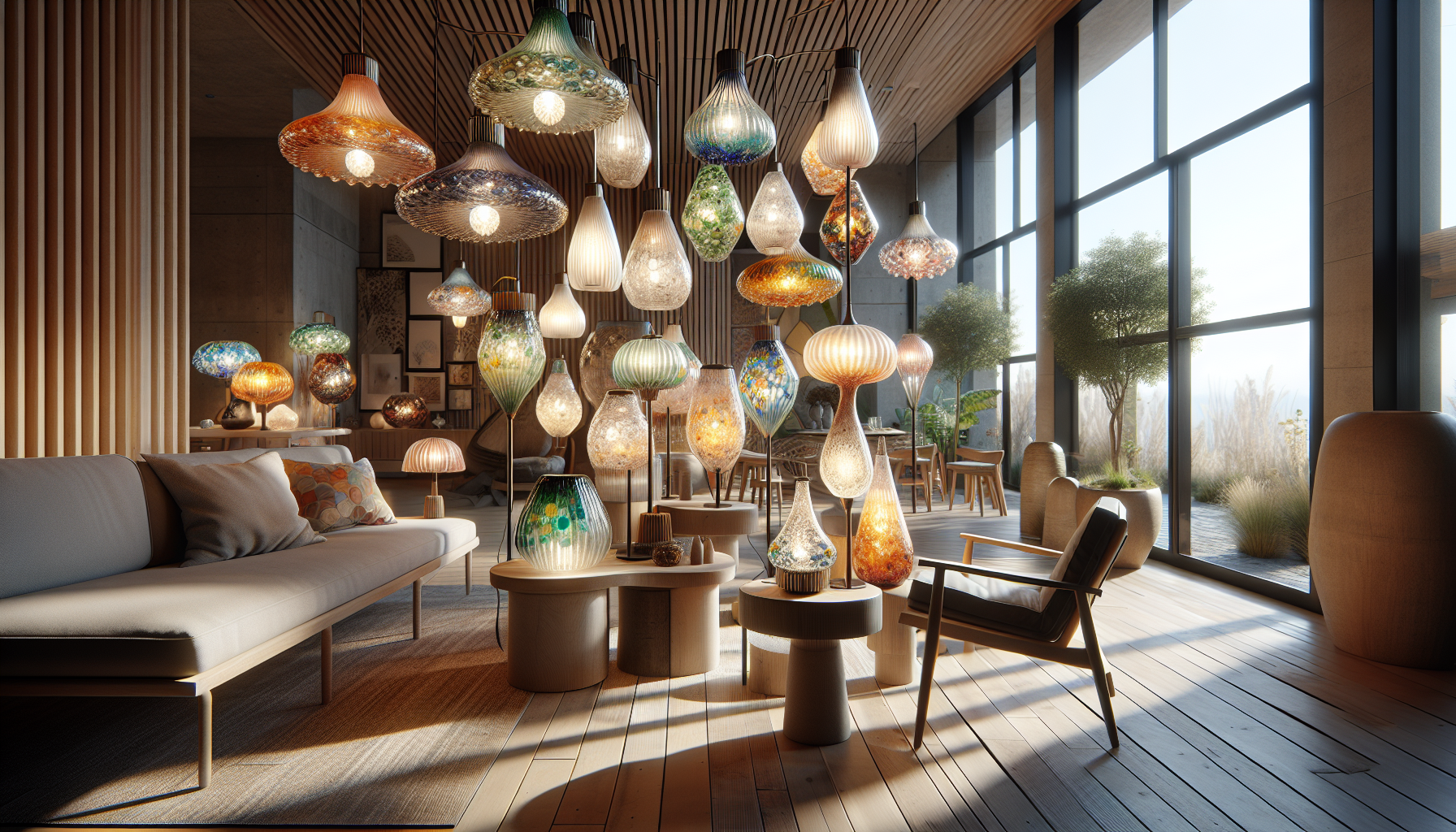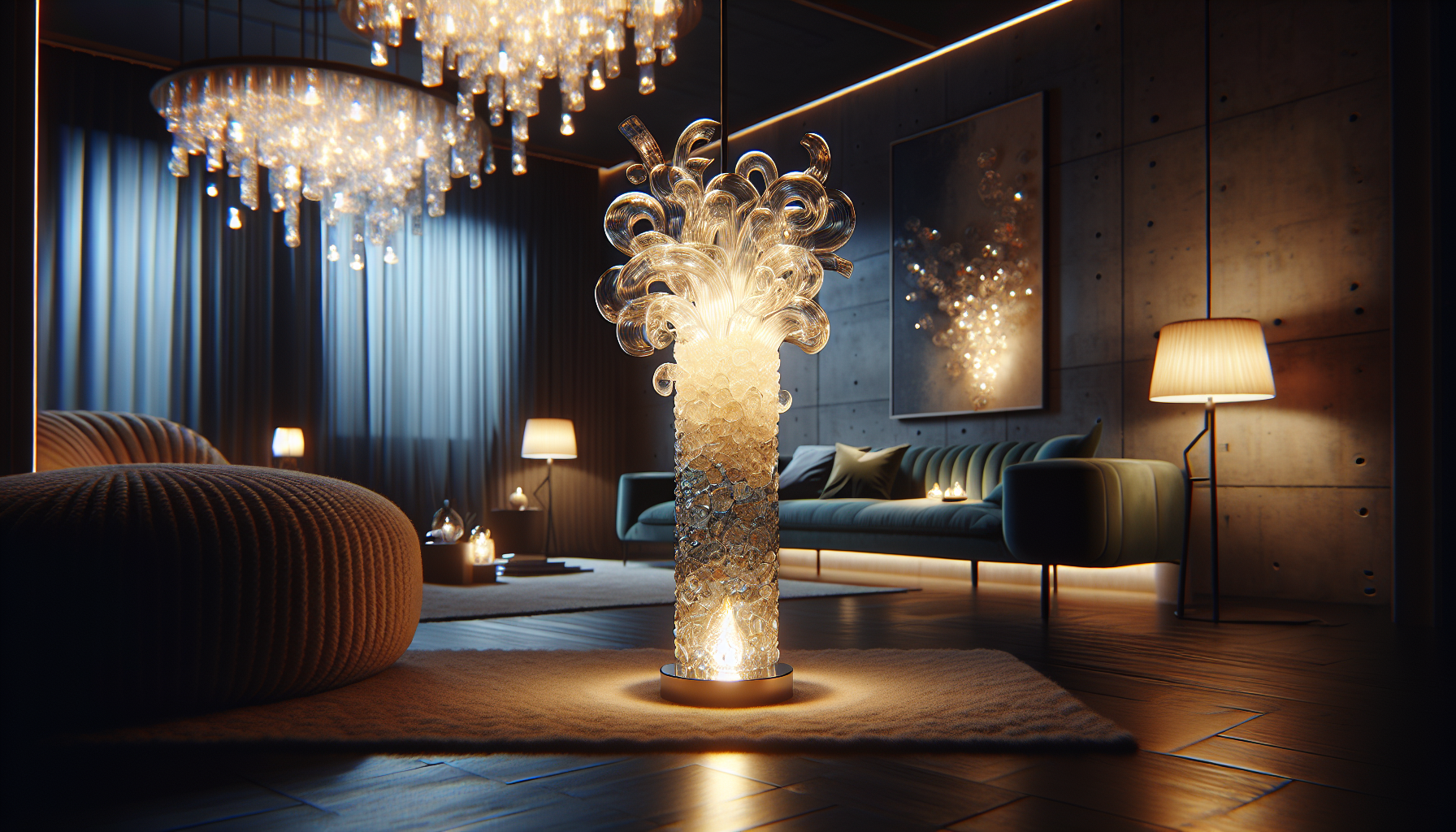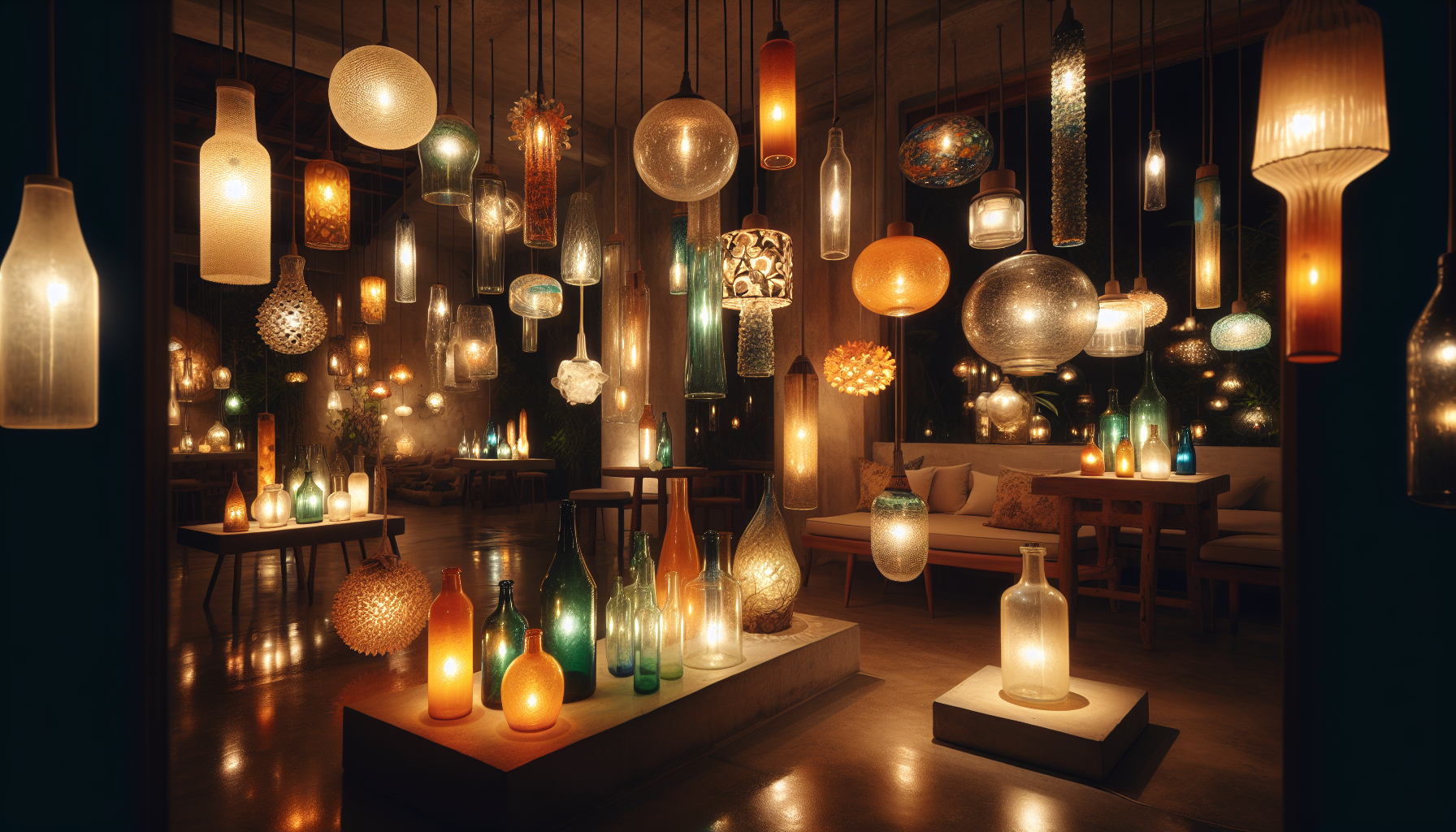In a world increasingly attuned to the imperatives of sustainability, the art of interior design is undergoing a transformative shift. It’s no longer just about aesthetics or comfort; it’s about creating spaces that reflect our values and aspirations for a more harmonious coexistence with our environment. Amid this evolution, one trend is illuminating homes across the globe: sculptural glass lamps crafted from fused, recycled bottles. These innovative lighting solutions offer a radiant blend of style, sustainability, and ingenuity, making them a captivating choice for those who wish to illuminate their homes with a touch of brilliance and conscience. 🌍💡
Imagine stepping into a room where every detail speaks to your sense of style and your commitment to sustainability. The centerpiece of this space? A stunning lamp that tells a story of transformation—ordinary glass bottles, once discarded, now reborn as a work of art that glows with elegance. These sculptural glass lamps are not just lighting fixtures; they are statements of creativity and environmental stewardship. Each piece is uniquely handcrafted, ensuring that no two lamps are exactly alike, much like the individual spirits they illuminate. They stand as a testament to the beauty that can arise from thoughtful repurposing and creative innovation.
As we explore the world of these remarkable glass lamps, we’ll delve into the fascinating process of their creation. From the collection of used bottles to the intricate artistry of glass fusion, each step is a testament to human ingenuity and dedication. We’ll uncover the craftsmanship involved in transforming what some might consider waste into luminous pieces of functional art. By the end of this journey, you’ll gain a newfound appreciation for the artisans who breathe new life into recycled materials and the intricate techniques they employ to create such dazzling results.
Moreover, we’ll examine the impact these sculptural lamps can have on your living space. Beyond their obvious aesthetic appeal, these lamps offer practical benefits as well. We’ll discuss how their unique designs can enhance the ambiance of any room, casting enchanting patterns of light and shadow that add depth and character. Furthermore, by choosing lighting solutions that utilize recycled materials, you’re making a conscious choice to support sustainable practices, reducing waste and minimizing your ecological footprint. It’s a win-win situation that marries beauty with responsibility, proving that you don’t have to sacrifice style to be environmentally conscious.
The Art of Glass: Transforming Recycled Bottles into Sculptural Lamps
In the realm of interior design, lighting is more than just an illumination tool; it’s a way to express style and create ambiance. Recently, sculptural lamps made from artisanally fused glass, using recycled bottles, have emerged as a sustainable and aesthetically pleasing trend. These lamps not only serve as functional art pieces but also make significant contributions to environmental conservation. The process of transforming everyday glass bottles into works of art is both fascinating and commendable, involving various meticulous techniques and a deep understanding of materials.
The crafting process starts with the collection of glass bottles, which are then cleaned and prepared for transformation. Artists typically select bottles based on color, thickness, and type of glass, considering how these factors will affect the final design. The next step involves cutting the bottles into desired shapes, which requires precision and skill. This is followed by the fusing process, where pieces are melted together under controlled heat conditions. Fusing glass is an intricate process that involves controlling temperature and time to ensure that the glass pieces meld together without losing their individual characteristics.
Once the glass has been successfully fused, it is shaped into the desired lamp form. This could involve blowing, molding, or further cutting and fusing to achieve the final artistic vision. Each piece is unique, owing to the variability in bottle glass and the handcrafted nature of the work. These lamps not only bring elegance and uniqueness to a room but also promote sustainability by repurposing materials that would otherwise contribute to landfill waste. This intersection of art and sustainability makes sculptural glass lamps a brilliant choice for environmentally conscious interior design.
Sustainability in Interior Design: Why It Matters
In an era where environmental issues are at the forefront of global discourse, the adoption of sustainable practices in interior design is not just a trend but a necessity. Using recycled materials, like glass bottles, for creating sculptural lamps is a perfect example of how sustainability can be integrated into design. This approach minimizes waste and reduces the demand for new raw materials, leading to a decrease in energy consumption and carbon footprint. Moreover, sustainable designs tend to resonate more with consumers who are becoming increasingly eco-conscious.
Designers and homeowners alike are recognizing the importance of choosing sustainable options that align with their values. Sculptural lamps made from recycled glass fit seamlessly into this narrative, offering a stylish yet responsible choice. They illustrate that sustainability does not have to come at the expense of aesthetics or quality. On the contrary, such designs often add an element of uniqueness and craftsmanship that mass-produced items cannot offer. The appeal of these lamps lies not only in their environmental benefits but also in their ability to tell a story through their design and materials.
Furthermore, integrating sustainable designs like recycled glass lamps into interiors can inspire conversations about environmental responsibility and innovation. These pieces can serve as a testament to the fact that beauty and sustainability can coexist, leading to more mindful consumption patterns. As more people become aware of the impact of their purchasing decisions, the demand for sustainable products is expected to grow, further encouraging designers to embrace eco-friendly practices.
Comparative Analysis: Traditional Lamps vs. Recycled Glass Lamps
To truly understand the value of recycled glass lamps, it’s useful to compare them with traditional lighting options. Traditional lamps are often mass-produced using new materials, which can lead to environmental degradation through resource extraction and energy consumption. In contrast, recycled glass lamps utilize existing materials, reducing the need for new raw materials and associated environmental impacts.
Let’s take a closer look at the differences between these two types of lamps through a comparative table:
| Aspect | Traditional Lamps | Recycled Glass Lamps |
|---|---|---|
| Material Source | New raw materials | Recycled glass bottles |
| Production Process | Mass-produced | Handcrafted, artisanally fused |
| Environmental Impact | Higher carbon footprint | Reduced waste, lower carbon footprint |
| Aesthetic Appeal | Uniform, standard designs | Unique, one-of-a-kind pieces |
| Durability | Varies, often lower | High, due to handcrafted nature |
As seen in the table, recycled glass lamps offer significant advantages over traditional options, particularly in terms of environmental impact and aesthetic uniqueness. They are not only a sustainable choice but also a testament to human creativity and craftsmanship.
Bringing Artistic Lighting into Your Home: Tips and Ideas
Incorporating sculptural glass lamps into your home decor can be a delightful experience. These lamps, with their unique designs and vibrant colors, can transform any space, adding an artistic touch that captivates and inspires. When considering how to integrate these lamps into your interior design, it’s essential to think about the overall aesthetic you wish to achieve and how the lamp can complement or enhance it.
One popular approach is to use these lamps as statement pieces. Placing a sculptural glass lamp in a prominent location, such as a living room or entryway, allows it to become a focal point, drawing attention and sparking conversations. The lamp’s design should contrast with or complement other elements in the room, creating a harmonious yet eye-catching ensemble. It’s also worth considering the color palette of the lamp and how it interacts with your existing decor. Vibrant hues can add a pop of color to neutral settings, while more subdued tones might integrate seamlessly with a more colorful space.
Functionality is another important factor. While sculptural glass lamps are undoubtedly artistic, they should also serve their primary purpose of providing adequate lighting. Consider the lamp’s placement in relation to natural light sources and other lighting fixtures in the room. It’s essential to strike a balance between creating ambiance and ensuring practicality. Some designs offer adjustable lighting features, which can be particularly useful for creating different moods or highlighting specific areas of a room.
Embracing the DIY Spirit: Creating Your Own Recycled Glass Lamp
For those who are creatively inclined and eco-conscious, making your own recycled glass lamp can be an immensely rewarding project. This endeavor allows you to personalize your design while engaging in sustainable practices. The first step is gathering materials, specifically glass bottles of various shapes and colors. Thrift stores, recycling centers, and even your kitchen might yield potential candidates for this project.
Once you’ve collected your bottles, the next step is cutting and preparing the glass. This process requires careful attention to safety, as handling glass can be hazardous. Investing in a good glass cutter and protective gear, such as gloves and goggles, is crucial. After cutting the bottles into desired shapes, you can experiment with arranging them in different configurations to find a design that resonates with your vision.
The fusing process typically requires a kiln, which may be accessible through community art centers or shared maker spaces. Alternatively, there are cold-working techniques that do not require high heat, though they might limit the design possibilities. Regardless of the method, creating your lamp offers a unique opportunity to learn about glasswork while contributing to environmental sustainability.
If you’re interested in exploring this creative journey further, consider watching the video “How to Make a Recycled Glass Bottle Lamp” on the DIY Network YouTube channel. This resource provides step-by-step guidance and inspiration for crafting your own lighting masterpiece.
The Future of Sustainable Lighting: Trends and Innovations
As awareness of environmental issues continues to grow, the future of lighting design is likely to focus increasingly on sustainability and innovation. The trend of using recycled materials, such as glass bottles, is just one aspect of this broader movement. Other innovations include advancements in energy-efficient lighting, like LED technology, and smart lighting systems that can be controlled remotely to optimize energy use.
The integration of technology with sustainable design opens up exciting possibilities for the future. Imagine sculptural lamps that not only use recycled materials but also incorporate smart features, such as color-changing capabilities or automated brightness adjustments based on ambient light levels. Such innovations would enhance both the aesthetic and functional aspects of lighting design, making it more adaptable and user-friendly.
Moreover, the emphasis on sustainability is likely to drive further exploration of materials and processes that minimize environmental impact. Designers might experiment with other types of recycled materials or develop new techniques for glass fusion that require less energy. Collaboration between designers, engineers, and environmental scientists could lead to breakthroughs in sustainable design that we have yet to imagine.
Get Involved: Supporting Sustainable Design Initiatives
If you’re passionate about sustainability and design, there are several ways to get involved and support initiatives in this field. Consider investing in products from companies that prioritize eco-friendly practices. Your purchasing decisions can have a significant impact, encouraging more businesses to adopt sustainable methods. Additionally, participating in community projects or workshops focused on recycling and design can expand your knowledge and allow you to contribute to meaningful change.
Engage with online communities and forums dedicated to sustainable design, where you can exchange ideas, learn about the latest trends, and connect with like-minded individuals. Social media platforms and websites often feature discussions and resources related to sustainable practices in various industries, including lighting design. By staying informed and actively participating, you can be part of a movement that shapes the future of interior design in a positive and sustainable direction.
- Choose lamps made from recycled materials to reduce environmental impact.
- Explore DIY projects to create personalized and sustainable lighting solutions.
- Stay informed about trends and innovations in sustainable design.

Conclusion
Creating a space that resonates with both elegance and environmental responsibility has never been more attainable than with the innovative use of sculptural lamps crafted from artisanally fused glass, derived from recycled bottles. This approach not only champions sustainable practices but also elevates the aesthetic value of any room, turning mundane spaces into brilliant showcases of style and consciousness.
Throughout this article, we’ve explored the transformative power of these unique lighting solutions. We began by discussing the environmental impact of recycling glass and how repurposing bottles into artistic lamp designs contributes to reducing waste. By choosing these eco-friendly options, you’re not just enhancing your interior decor but actively participating in a movement towards sustainability. The process of glass fusion itself is a testament to human ingenuity—combining art and science to produce stunning pieces that captivate the eye and warm the soul.
The aesthetic versatility of glass lamps was another focal point. We delved into how these pieces can complement a variety of interior styles, from modern minimalism to rustic charm. The transparency and light-reflective qualities of glass add depth and dimension to a room, creating an inviting and dynamic atmosphere. Whether as a statement piece in the living room or a subtle accent in the bedroom, glass lamps offer endless possibilities for personalization and creativity.
Moreover, the craftsmanship involved in creating these lamps is truly remarkable. Each piece is a labor of love, showcasing the skill and dedication of artisans who transform discarded materials into works of art. By supporting these craftsmen, we not only acquire a beautiful object but also contribute to preserving traditional skills and promoting fair trade practices. It’s an investment in culture and community that pays dividends in beauty and ethical satisfaction.
The article also highlighted the practical aspects of integrating glass lamps into your home. We discussed considerations such as size, placement, and lighting needs, ensuring that your new fixture harmonizes with existing decor while providing the desired level of illumination. Proper lighting can significantly influence the mood and functionality of a space, and glass lamps offer a unique blend of ambient, task, and accent lighting that can be tailored to suit any requirement.
In closing, embracing the use of sculptural lamps crafted from recycled glass bottles is more than just a design choice—it’s a commitment to a brighter, more sustainable future. These pieces inspire us to rethink our relationship with materials, urging us to see potential where others might see waste. By incorporating such elements into our homes, we not only enhance our living environments but also set an example for others to follow.
I encourage you to take the insights shared in this article and explore how you can implement them in your own spaces. Consider the impact of your choices and how they align with your values. And as you transform your environment, share your journey with others. Engage in discussions, exchange ideas, and inspire those around you to consider the beauty and potential of sustainable design. Together, we can illuminate not only our homes but also the path to a more responsible and aesthetically pleasing world. 🌍💡
Feel free to explore more about sustainable design practices and their impact here and discover the beauty of glass artistry from recycled materials here. Let’s keep the conversation going and continue to build a community that values both style and sustainability.
Toni Santos is a lighting artisan and visual explorer who designs atmospheres, not just objects. With a refined sensitivity to form, reflection, and emotion, Toni’s work at Sordux is an ode to how light transforms space, feeling, and story.
Through his handcrafted creations — from artistic glass bottles to radiant lighting totems — Toni invites us to see light as more than function. To him, light is symbolic. It is memory, energy, and meaning in motion.
Drawing inspiration from modern minimalism, ancestral aesthetics, and organic shapes, Toni blends natural materials with ambient expression. His collections are not just decorative — they’re immersive experiences, each one crafted to awaken the senses and reconnect us to the spaces we inhabit.
As the mind behind Sordux, Toni curates a world where illumination becomes ritual, and where every design element — from the curvature of a bottle to the hue of a glow — speaks of intention and presence.
🔥 His vision shines through:
-
Designs that merge mood with form
-
Bottled light as symbolic storytelling
-
Sustainable aesthetics rooted in artistic function
Whether you’re a designer, a dreamer, or someone who understands that light is a language of its own, Toni invites you into a world where glow becomes meaning, and every beam is an invitation to feel.




